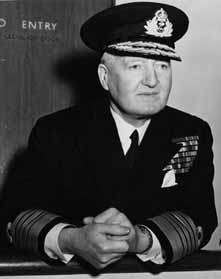- Author
- Plater, Robert, Midshipman, RAN
- Subjects
- Biographies and personal histories
- Tags
-
- RAN Ships
- None noted.
- Publication
- September 2007 edition of the Naval Historical Review (all rights reserved)
The aim of this essay is to examine the circumstances and life experiences which contributed to leadership qualities seen in Admiral Sir Bruce Fraser that allowed him to rise to the highest position in the Royal Navy. Fraser was proficient in the science of the Navy, maintained the human qualities that empowered and encouraged his subordinates to reach their full potential, and further fulfilled the principles of leadership with sound and timely decisions in the heat of battle.

Bruce Austin Fraser, born in London on 5 February 1888, commenced his Navy career as Midshipman on HMS Britannia, where he gained high proficiency in mathematics and seamanship and witnessed great changes in the modernising and restructuring of the Royal Navy, providing an invaluable lesson in altering the status quo with a positive effect. As a junior officer on the destroyer HMS Boadicea Fraser had the good fortune to be commanded by Rear-Admiral Sir Robert Arbuthnot, whose leadership style proved to be a major influence. Arbuthnut showed interest in his officers’ development and generated a high level of trust with those who proved themselves. Furthermore, Arbuthnut maintained a distance from the politics of the Admiralty, an example Fraser would never forget.
Fraser’s next posting was to the Navy’s Gunnery school, HMS Excellent, the ‘authority in drill and ceremonial, demanding the highest standards in immaculate precision’. One module was a lecture by each student. Here Arbuthnot’s lesson on politics within the Navy proved its worth when Fraser, advocating ‘director firing’, all guns directed by a central controller, but instead lectured on ‘fire control’, the status quo where each gun has its own controller. He finished head of his class and within a year director firing was adopted by the Royal Navy. Fraser authored the first Handbook of Director Firing.
Employing the exacting standards of gunnery school, backed by Arbuthnot’s leadership virtues, Fraser built crew morale and made HMS Minerva ‘the most efficient gunnery ship in the fleet’.
Fraser had a hands-on approach, so much so that, when Mediterranean Fleet Gunnery Officer, he stood on the deck of a target ship during fleet gunnery practice. This continued as commander of the aircraft carrier HMS Glorious, where Fraser broke down the barriers between the Navy, who drove the ships, and Air Force, who flew the planes. It was common to see RAF officers on the bridge and RN officers in the planes. This unprecedented cooperation fostered trust within a happy ship, and provided the inputs for the first night flight operations from a ship at sea. This demonstrated the great potential of carriers and gave Fraser vital experience he would need with the British Pacific Fleet.
In 1938 Fraser was promoted to Rear-Admiral and appointed as Chief of Staff, Mediterranean Fleet. In his position, Fraser was never afraid to voice his opinion, but always ensured that the decision of the commander was followed through without prejudice. One such idea advocated closer inter-service cooperation, stating ‘the tendency … for each Service to prepare its own plans’, referring to the failed Gallipoli campaign. His foresight, ability for detailed strategic planning and exceptional record of achievement was recognised when appointed Controller of the Navy and Third Sea Lord in 1939.
As Controller, Fraser initiated the War Emergency Programme, a massive building programme for both escort and war fleet vessels. The significance of the submarine threat meant Fraser had to tackle quickly a new area of naval warfare. It could be said that this was the final proficiency allowing him to become Second-In-Command of the Home Fleet in June 1942.
At the time the Home Fleet was running convoys to Russia ‘against increasing enemy opposition’. But before Fraser took command, it was the Admiralty, not the commander at sea, which was to blame for tragic losses of convoy PQ.17. With the German Fleet still in harbour the Admiralty gave, from London, the order to scatter, ‘an “informed decision” made in the absence of true information’. Operational procedure dictated radio silence at sea, a procedure Fraser ‘privately vowed’ not to follow ‘as often as necessary for the right hand to know what the left hand was doing’.
In June 1940 Scharnhorst sank Glorious, a year later ‘broke out’ to the Atlantic causing havoc, then anchored unscathed in Brest to the chagrin of the RAF, before running the gauntlet of the English Channel during daylight in February 1942. Ominously for the Russian convoys the Scharnhorst was stationed at North Cape. Momentously Fraser was offered and then declined the position of First Sea Lord telling Churchill ‘If one day I should sink the Scharnhorst, I might feel differently.’




